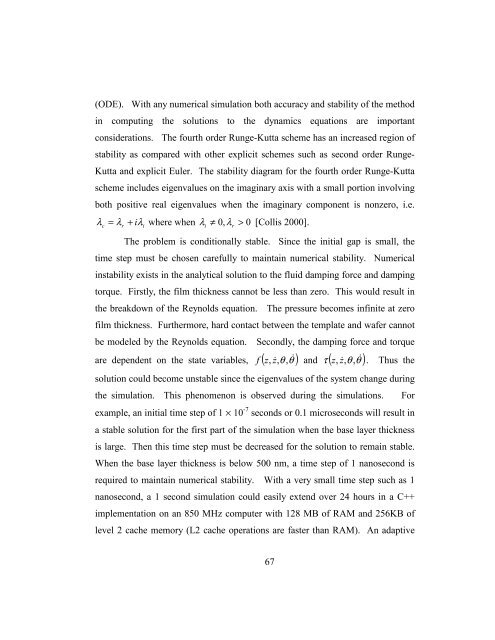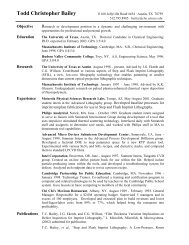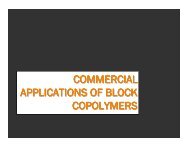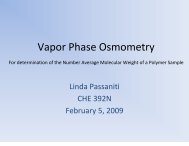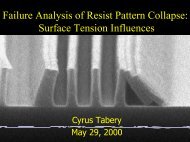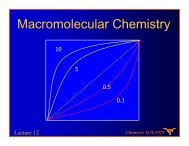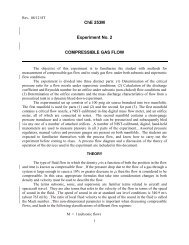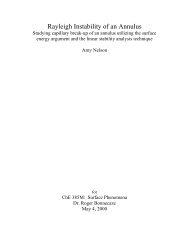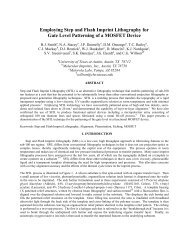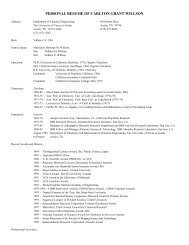Asymmetric fluid-structure dynamics in nanoscale imprint lithography
Asymmetric fluid-structure dynamics in nanoscale imprint lithography
Asymmetric fluid-structure dynamics in nanoscale imprint lithography
- No tags were found...
You also want an ePaper? Increase the reach of your titles
YUMPU automatically turns print PDFs into web optimized ePapers that Google loves.
(ODE). With any numerical simulation both accuracy and stability of the method<strong>in</strong> comput<strong>in</strong>g the solutions to the <strong>dynamics</strong> equations are importantconsiderations. The fourth order Runge-Kutta scheme has an <strong>in</strong>creased region ofstability as compared with other explicit schemes such as second order Runge-Kutta and explicit Euler. The stability diagram for the fourth order Runge-Kuttascheme <strong>in</strong>cludes eigenvalues on the imag<strong>in</strong>ary axis with a small portion <strong>in</strong>volv<strong>in</strong>gboth positive real eigenvalues when the imag<strong>in</strong>ary component is nonzero, i.e.λ = λ + iλ where when λ ≠ 0 , λ > 0 [Collis 2000].criirThe problem is conditionally stable. S<strong>in</strong>ce the <strong>in</strong>itial gap is small, thetime step must be chosen carefully to ma<strong>in</strong>ta<strong>in</strong> numerical stability. Numerical<strong>in</strong>stability exists <strong>in</strong> the analytical solution to the <strong>fluid</strong> damp<strong>in</strong>g force and damp<strong>in</strong>gtorque. Firstly, the film thickness cannot be less than zero. This would result <strong>in</strong>the breakdown of the Reynolds equation. The pressure becomes <strong>in</strong>f<strong>in</strong>ite at zerofilm thickness. Furthermore, hard contact between the template and wafer cannotbe modeled by the Reynolds equation. Secondly, the damp<strong>in</strong>g force and torqueare dependent on the state variables, f ( z, z, D θ , θ D ) and τ ( z , z, D θ , θD). Thus thesolution could become unstable s<strong>in</strong>ce the eigenvalues of the system change dur<strong>in</strong>gthe simulation. This phenomenon is observed dur<strong>in</strong>g the simulations. Forexample, an <strong>in</strong>itial time step of 1 × 10 -7 seconds or 0.1 microseconds will result <strong>in</strong>a stable solution for the first part of the simulation when the base layer thicknessis large. Then this time step must be decreased for the solution to rema<strong>in</strong> stable.When the base layer thickness is below 500 nm, a time step of 1 nanosecond isrequired to ma<strong>in</strong>ta<strong>in</strong> numerical stability. With a very small time step such as 1nanosecond, a 1 second simulation could easily extend over 24 hours <strong>in</strong> a C++implementation on an 850 MHz computer with 128 MB of RAM and 256KB oflevel 2 cache memory (L2 cache operations are faster than RAM). An adaptive67


